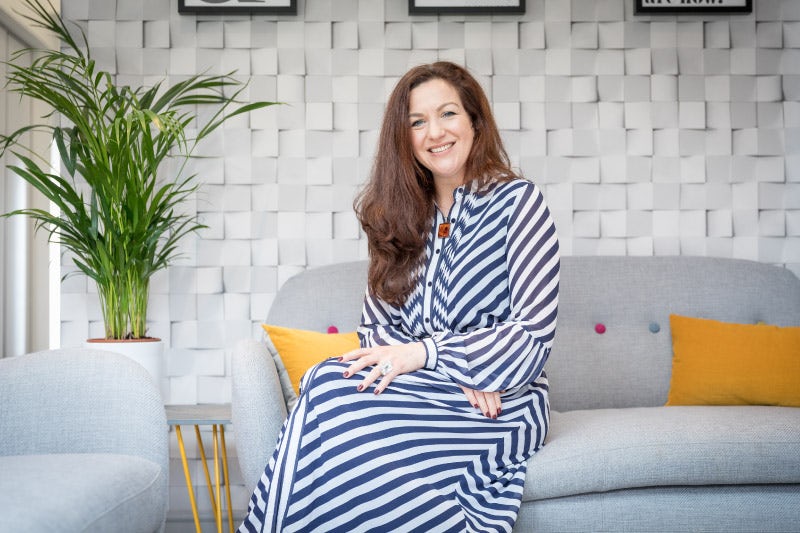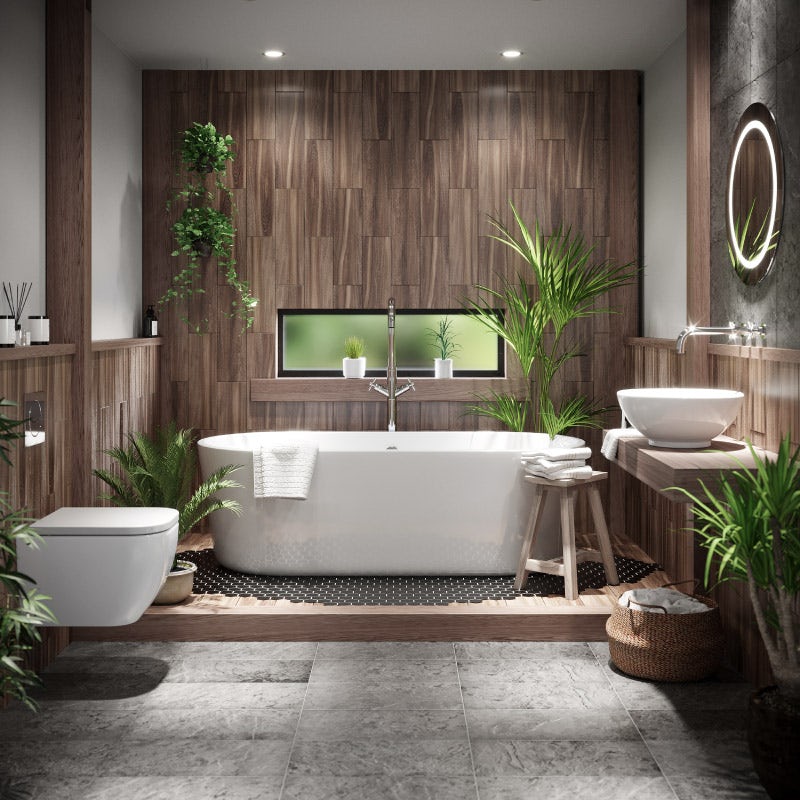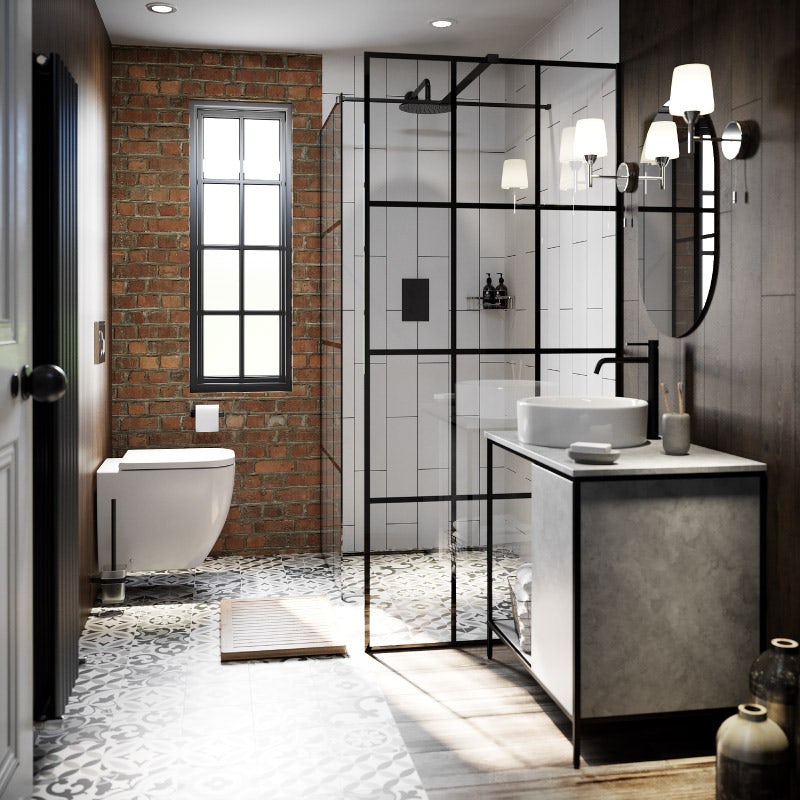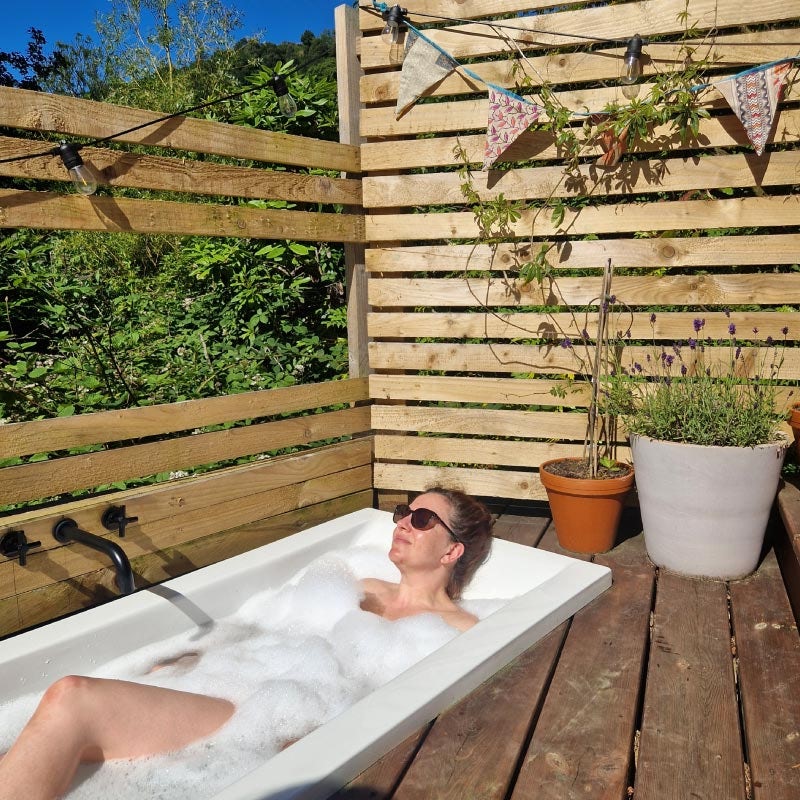For expert opinion on all things bathrooms, including renovations, refurbishments and even outdoor baths, we caught up with TV architect Laura Jane Clark.
If you’re a fan of home improvement shows like Your Home Made Perfect and Ugly House to Lovely House, you’ll no doubt know renowned architect Laura Jane Clark. Having founded her own studio, Lamp Architects, Laura is a strong believer in creating beautiful yet practical homes.
One of Laura’s first TV appearances came when her renovation of an underground toilet in Crystal Palace featured on George Clarke's Amazing Spaces in 2012. Since then, she has featured as a guest judge on the Channel 4 series “Shed of the Year”, showcased her flair for transforming unloved houses on Ugly House to Lovely House, and starred in the BBC series Your Home Made Perfect.
With over 15 years’ experience designing, extending and building houses on a budget, we asked Laura if she’d take a little time out of her busy schedule to chat bathrooms with us. Thankfully, she said yes!
Adam Chard: Hi Laura. Thanks for taking some time out to chat with us. Just in case any of our customers haven’t seen you on TV or read any of your articles, can you please tell us a little bit about yourself?
Laura Jane Clark: I’m an architect and I specialise in home renovations, small scale conversions and change of use. I love working on those odd, quirky projects, and getting the most out of small spaces. This is where there needs to be more design and focus. It’s something I’m really passionate about.
And, you’ve also featured on plenty of home improvement programmes like Your Home Made Perfect and Ugly House to Lovely House. How did this come about?
Going back a few years, I converted some old underground toilets in Crystal Palace, South London, into a one-bedroom flat, where I lived for a few years. That’s how I got on to George Clarke’s Amazing Spaces and, really, it all snowballed from there.
As well as your TV career, you also write for various home interest magazines and, am I right in saying you’ve just finished writing your first book?
Yes, I have. It’s called Handbook of Home Design: An Architect's Blueprint for Shaping your Home and it’s all about giving homeowners knowledge and a design method. While interiors can be quite accessible, architecture is still a little inaccessible to the average person. With this book, I wanted to introduce my own methodology and explain how I approach home design. This will help people learn more about the subject, understand the language we use, know how to speak with builders and basically empower them. It’s what I like to call “democratisation of design”.
That’s a great phrase! So, just moving on to the “littlest room”, what is your general approach to bathrooms?
Bathrooms are my favourite thing to design. When I worked on my own home (the aforementioned underground toilet conversion), I had always played it safe with beiges and perhaps a bit of marble. However, I decided I wanted to go bold with gold leaf and red tiles…although, halfway through, I felt like I was designing a Little Chef(!) and wasn’t sure it was going in the right direction. Thankfully, once it all came together, it looked fabulous. So, now, when it comes to bathrooms, I like to go a wee bit out-of-the-ordinary. After all, you don’t spend hours at a time in a bathroom—as you may do with, say, a living room, bedroom or home office—so you can afford to be that little bit more creative.

Was there a particular bathroom project that was a huge challenge?
I designed and built a timber bathroom in a tenement flat in Glasgow. One of my friends had given me some reclaimed Iroko wood, a hardwood used on boats, so decided the whole thing could have timber wall panels, plus a slatted floor with drainage concealed underneath and water from the shower passing straight through. It was one of my first solo projects, where my husband and I worked alongside the builders. I was so proud, as it was almost like achieving the impossible.
Going back to the underground toilets you converted, what inspired you to do this? I understand it was a very lengthy project.
Whilst the build was really quick—just 6 months—it took 7 years of planning. It all started when I walked past these old, abandoned underground toilets in Crystal Palace. I was intrigued, as no one seemed to know who owned them. After securing the property, I started looking at developing them into a bar, an independent cinema or perhaps an art space. This was back in 2008, and we had all the funding ready, but then came the global financial crisis and the project fell apart. Also, at this time, the smoking ban was introduced, so we also had to consider where a smoking area might go.
After going over and over the designs, we realised that it would be possible to convert the toilets into a home. So, after a few more years persuading the local council, they finally let us do it!
Many of our customers will be doing almost the opposite—turning a space in their home into a bathroom or toilet. Do you have any advice on adding a new bathroom?
The first thing to consider is how small your bathroom can be and also where your existing drainage is. I know it’s terribly boring, but some of the first questions I ask are: "Where’s your drain? Where’s your soil vent pipe?". Make sure your new loo isn’t too far away from that, so it’s easy to connect in.
If you’re reconfiguring, you could take a slice out of a couple of bedrooms to create a 700 or 800mm wide slot where you can fit a toilet and shower. Look at where your drainage connections are and, one of my golden rules, never open a door onto a toilet, unless you really have to.
Talking of small spaces, what’s the best way to tackle a small bathroom?
You don’t have to choose a really long tub. I love a deeper, shorter style of bath. The one I bought for my home was 1500mm long and, even with a smaller freestanding bath, it always looks lovely, making your bathroom feel instantly bigger. Another thing I like to do, especially when converting Victorian properties, is to raise the ceiling. So, you create height, even though you don’t have loads of space below and, if you can, put a lovely big, oversized skylight in. So even if your bathroom is quite small, it’s flooded with light.
A small space can even be turned into a wet room. Although, when they’re not done very well, they can give off budget hotel vibes! In this case, I would suggest using slightly darker tones.
I know what you mean about the wet room and accessible bathrooms in general. Something, we always try and do at Victoria Plum is demonstrate how a wet room can be just the opposite—stylish not sterile. Moving on, do you have any tips on creating a bathroom that will last?
In my experience, I would say choose your grout carefully. If you use a quality, epoxy grout, you’ll find it’s much easier to clean. The amount of time I have spent scrubbing grout! And, while we’re talking walls, tile trims are another thing to pay close attention to, especially if you plan on creating insets to form shelving. Don’t place your tiles edge on edge. While it looks beautiful it can chip easily.
Often, it can be overwhelming when trying to pair products, pick colours, patterns, textures, etc. As an architect first and foremost, do you have any advice on this?
It is tricky. I mean, I’m not an interior designer, but I love that side of it; the crossover between architecture and interiors. More architects should embrace it.
I would say, go bold and don’t necessarily follow a trend, instead, try following your heart. Another thing I’d say is don’t zone in on the specifics. Often, when I am dealing with clients, we take a step back, then realise it’s more about creating a space or a feeling, rather than picking out a specific tile!
Another thing I’d suggest is tying in all your metal work. If you’re going for matt black, gold, chrome or brushed steel, make sure the theme continues throughout your bathroom.
Are there any other features, some of which our readers might not have thought about, that you’d recommend for a bathroom?
Yes. When I was living in the converted underground toilets, dampness and humidity was a real problem. Indeed, it can be a real problem in bathrooms in general.
I’m a big fan of dehumidifiers. You can get dehumidifying fans which heat as well. They are very efficient and take a shorter time to heat up…a real game-changer!
One of your most recent projects was an outdoor bath, in Scotland of all places! What was the inspiration for this?
Years ago, I was in Yorkshire, and we went to this wonderful campsite and there was a little path which led to a beautiful, old walled garden. Inside this garden, which must’ve been the ruins of an old bathroom, there was a beautiful bath and tiled floor. I thought, at some point in my life, I would like a garden in which I can have an outdoor bath.
And you used Victoria Plum products in this project. Was there anything in particular which caught your eye?
The bath, with its straight sides, was absolutely ideal, as I could sink it into my decking. It’s really beautiful and very elegant. I also love your matt black range, as there is a great choice of taps, showers and accessories. Plus, you have some really nice shower screens. The way your products are curated in a simple, easy-to-understand fashion is also very good.
Something people might find surprising is that you fight competitively in MMA (Mixed Martial Arts). Is this still something you do?
I started kickboxing over 25 years ago, then discovered MMA and UFC (Ultimate Fighting Competition). I love fighting…it’s like my yoga. For me, it’s not about aggression. It's simply the most amazing thing to do.
Any injuries?
Well, after 5 competitive fights, I managed to avoid any real damage. However, recently, I was working on some decking. I did the classic…standing on the end of plank, which flew up and hit me square in the nose, breaking it. Thankfully, I’ve been lucky. It hasn’t caused too many problems.
Well, I hope it’s all feeling better now! Finally, if there is one golden piece of advice you could give a homeowner looking to renovate a bathroom for the first time, what would it be?
Go bold! Don’t worry about trends. Do something you absolutely love, so that every morning, when you wake up and walk into your bathroom, you think “ooo, I love this space!”.
Thanks for your time Laura. It’s been a fascinating and very insightful chat.
You can watch Laura in Your Home Made Perfect on Netflix now, and keep an eye out for the launch of her new book Handbook of Home Design: An Architect's Blueprint for Shaping your Home, which can be pre-ordered now.









